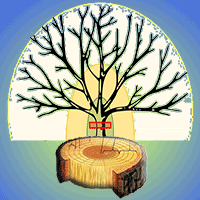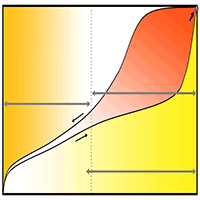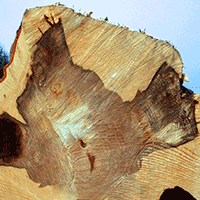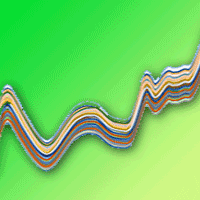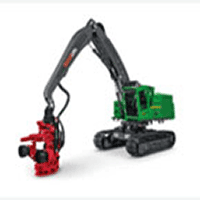Variability in bioactivity and chemical composition of Eucalyptus bosistoana F. Muell. heartwood extracts between individual trees from two different sites were investigated. Combining the results of fungal assays and quantitative gas chromatography (GC) of the extracts allowed the investigation of bioactive compounds. The bioactivity of extracts was assessed against white rot (Trametes versicolor [L.] Lloyd) and brown rot (Coniophora cerebella Pers.). Ethanol extracts from E. bosistoana heartwood were less effective on the white rot than against the brown rot. Variability in the bioactivity of extracts against the two fungi was observed between the trees. A site effect in the bioactivity was found for the white rot but not the brown rot. Bioactivity of the extracts against the white rot was not correlated to that against the brown rot. The absence of a relationship between of effects of the extracts on the relative growth rates of the white rot and the brown rot indicated that the two fungi were affected by different compounds. Thirty two compounds were quantified in E. bosistoana ethanol extracts by GC, of which six (benzoic acid, hexadecanoic acid, 1,5-dihdroxy-12-methoxy-3,3-dimethyl-3,4-dihydro-1H-anthra[2,3-c]pyran-6,11-dione, octadecanoic acid, polyphenol and beta-sitosterol) were identified. Significant variability in eight compounds was found between the two sites. Multivariate (PLSR) analysis identified compounds at the retention times 10.2 and 11.5 min (hexadecanoic acid) to be most related to the bioactivity of the E. bosistoana heartwood extracts against white rot and brown rot.
Keywords
, , , , ,
Citation
Mishra G, Garrill A, Altaner CM (2019). Bioactivity of ethanol extracts from Eucalyptus bosistoana F. Muell. heartwood. iForest 12: 467-473. - doi: 10.3832/ifor3072-012
Academic Editor
Giacomo Goli
Paper history
Received: Feb 15, 2019
Accepted: Jul 23, 2019
First online: Oct 14, 2019
Publication Date: Oct 31, 2019
Publication Time: 2.77 months
© SISEF - The Italian Society of Silviculture and Forest Ecology 2019
Open Access
This article is distributed under the terms of the Creative Commons Attribution-Non Commercial 4.0 International (https://creativecommons.org/licenses/by-nc/4.0/), which permits unrestricted use, distribution, and reproduction in any medium, provided you give appropriate credit to the original author(s) and the source, provide a link to the Creative Commons license, and indicate if changes were made.

Breakdown by View Type
(Waiting for server response...)
Article Usage
Total Article Views: 41447
(from publication date up to now)
Breakdown by View Type
HTML Page Views: 35564
Abstract Page Views: 2566
PDF Downloads: 2560
Citation/Reference Downloads: 1
XML Downloads: 756
Web Metrics
Days since publication: 2275
Overall contacts: 41447
Avg. contacts per week: 127.53
Article Citations
Article citations are based on data periodically collected from the Clarivate Web of Science web site
(last update: Mar 2025)
(No citations were found up to date. Please come back later)
Publication Metrics
by Dimensions ©
Articles citing this article
List of the papers citing this article based on CrossRef Cited-by.
(1)
Altaner C, Murray T, Morgenroth J (2017)Durable eucalypts on drylands: protecting and enhancing value. Proceeding of the Workshop “Durable eucalypts on drylands: protecting and enhancing value”. Blenheim (NZ), 19 Apr 2017. New Zealand School of Forestry, University of Canterbury, Christchurch, New Zealand, pp. 1-139.
Gscholar
(2)
AWPC (2007)Protocols for assessment of wood preservatives. The Australian Wood Preservation Committee, Clayton, Australia, pp. 30.
Gscholar
(3)
Benouadah N, Pranovich A, Aliouche D, Hemming J, Smeds A, Willför S (2018)Analysis of extractives from
Pinus halepensis and
Eucalyptus camaldulensis as predominant trees in Algeria. Holzforschung 72: 97-104.
CrossRef |
Gscholar
(4)
Brooker MH (2000)A new classification of the genus
Eucalyptus L’Her. (Myrtaceae). Australian Systematic Botany 13: 79-148.
CrossRef |
Gscholar
(5)
Bootle KR (2005)Wood in Australia. Types, properties, and uses (2
nd edn). McGraw-Hill, Australia, pp. 452.
Gscholar
(6)
Bush D, McCarthy K, Meder R (2011)Genetic variation of natural durability traits in
Eucalyptus cladocalyx (sugar gum). Annals of Forest Science 68:1057-1066.
CrossRef |
Gscholar
(7)
Conde E, Cadahía E, García-Vallejo MC, Fernandez de Simón MB (1995)Polyphenolic composition of wood extracts from
Eucalyptus camaldulensis, E. globulus and
E. rudis. Holzforschung 49 (5): 411-417.
CrossRef |
Gscholar
(8)
Davies NT, Wu HF, Altaner CM (2014)The chemistry and bioactivity of various heartwood extracts from redwood (
Sequoia sempervirens) against two species of fungi. New Zealand Journal of Forestry Science 44: 17-21.
CrossRef |
Gscholar
(9)
Fernandez M, Watson P, Breuil C (2001)Gas chromatography-mass spectrometry method for the simultaneous determination of wood extractive compounds in quaking aspen. Journal of Chromatography A 922: 225-233.
CrossRef |
Gscholar
(10)
Guchu E, Conseulo M, Marato IJD, Lamireo PV, Coello MSP (2006)Influence of the species and geographical location on volatile composition of spanish oak wood (
Quercus petraea Liebl. and
Quercus robur L.). Journal of Agricultural and Food Chemistry 54: 3062-3066.
CrossRef |
Gscholar
(11)
Gutiérrez A, Rio JC, González FJ, Martin F (1998)Analysis of lipophilic extractives from wood and pitch deposits by solid-phase extraction and gas chromatography. Journal of Chromatography A 823: 449-455.
CrossRef |
Gscholar
(12)
Harju AM, Venäläinen M, Anttonen S, Viitanen H, Kainulainen P, Saranpää P, Vapaavuori E (2003)Chemical factors affecting the brown-rot decay resistance of Scots pine heartwood. Trees 17 (3): 263-268.
Online |
Gscholar
(13)
Hart JH, Hillis W (1972)Inhibition of wood-rotting fungi by ellagitannins in the heartwood of
Quercus alba. Phytopathology 62: 620-626.
CrossRef |
Gscholar
(14)
Hillis W (1971)Distribution, properties and formation of some wood extractives. Wood Science and Technology 5: 272-289.
CrossRef |
Gscholar
(15)
Hillis W, Hart JH, Yazaki Y (1974)Polyphenols of
Eucalyptus sideroxylon wood. Phytochemistry 13: 1591-1595.
CrossRef |
Gscholar
(16)
Hillis W (1987)Heartwood and tree exudates. Springer, New York, pp. 268.
Gscholar
(17)
Hillis W (1991)Eucalypts: chemistry, uses. Appita Journal 44: 239-244.
Gscholar
(18)
Kilulya KF, Msagati TA, Mamba BB, Ngila JC, Bush T (2014)Effect of site, species and tree size on the quantitative variation of lipophilic extractives in
Eucalyptus woods used for pulping in South Africa. Industrial Crops and Products 56: 166-174.
CrossRef |
Gscholar
(19)
Kirker G, Blodgett A, Arango R, Lebow P, Clausen C (2013)The role of extractives in naturally durable wood species. International Biodeterioration and Biodegradation 82: 53-58.
CrossRef |
Gscholar
(20)
Kokutse AD, Stokes A, Baillères H, Kokou K, Baudasse C (2006)Decay resistance of Togolese teak (
Tectona grandis Lf) heartwood and relationship with colour. Trees 20: 219-223.
CrossRef |
Gscholar
(21)
Morais MC, Pereira H (2012)Variation of extractives content in heartwood and sapwood of
Eucalyptus globulus trees. Wood Science and Technology 46: 709-719.
CrossRef |
Gscholar
(22)
Morris PI, Stirling R (2012)Western red cedar extractives associated with durability in ground contact. Wood Science and Technology 46: 991-1002.
CrossRef |
Gscholar
(23)
Mosedale J, Charrier B, Crouch N, Janin G, Savill P (1996a)Variation in the composition and content of ellagitannins in the heartwood of European oaks (
Quercus robur and
Q. petraea). A comparison of two French forests and variation with heartwood age. Annals of Forest Science 53 (5): 1005-1018.
CrossRef |
Gscholar
(24)
Mosedale J, Charrier B, Janin G (1996b)Genetic control of wood colour, density and heartwood ellagitannin concentration in European oaks (
Quercus petraea and
Q. robur). Forestry 69: 111-124.
CrossRef |
Gscholar
(25)
Ohtani Y, Noguchi T, Ichiura H (2009)Relationship between sugi (
Cryptomeria japonica) butt-rot disease and norlignans in the heartwood. Journal of the Japan Wood Research Society 55: 92-100.
CrossRef |
Gscholar
(26)
Prida A, Puech JL (2006)Influence of geographical origin and botanical species on the content of extractives in American, French, and East European oak woods. Journal of Agricultural and Food Chemistry 54: 8115-8126.
CrossRef |
Gscholar
(27)
Puech FF, Mosedale JR (1999)The tannins of oak heartwood: structure, properties, and their influence on wine flavor. American Journal of Enology and Viticulture 50: 469-478.
Online |
Gscholar
(28)
Roff J, Atkinson J (1954)Toxicity tests of a water-soluble phenolic fraction (thujaplicin-free) of western red cedar. Canadian Journal of Botany 32: 308-309.
CrossRef |
Gscholar
(29)
Rudman P (1964)Durability in the genus
Eucalyptus. Australian Forestry 28: 242-257.
CrossRef |
Gscholar
(30)
Sanchez G (2012)Partial least squares (PLS) data analysis methods. R package version 0.1.17, web site.
Online |
Gscholar
(31)
Schroettke N (2018)Natural variability in the extract composition of
Eucalyptus globoidea. Master’s thesis, MSc in Forestry, Institute of Chemical Wood Technology. University of Hamburg, Germany, pp. 57.
Gscholar
(32)
Sitholé B, Sullivan J, Allen L (1992)Identification and quantitation of acetone extractives of wood and bark by ion exchange and capillary GC with a spreadsheet program. Holzforschung 46: 409-416.
CrossRef |
Gscholar
(33)
Smeds AI, Eklund PC, Willför SM (2018)Characterization of high-molar-mass fractions in a Scots pine (
Pinus sylvestris L.) knotwood ethanol extract. Holzforschung 72: 201-213.
CrossRef |
Gscholar
(34)
Stackpole D, Vaillancourt R, Alves A, Rodrigues J, Potts B (2011)Genetic variation in the chemical components of
Eucalyptus globulus wood. G3: Genes, Genomes, Genetics 1: 151-159.
CrossRef |
Gscholar
(35)
Taylor AM, Gartner BL, Morrell JJ (2002)Heartwood formation and natural durability - A review. Wood and Fiber Science 34: 587-611.
Online |
Gscholar
(36)
R Core Team (2013)R: a language and environment for statistical computing. R Foundation for Statistical Computing, Vienna, Austria.
Online |
Gscholar
(37)
Thulasidas P, Bhat K (2007)Chemical extractive compounds determining the brown-rot decay resistance of teak wood. Holz als Roh- und Werkstoff 65: 121-124.
CrossRef |
Gscholar
(38)
Wilkes J (1984)The influence of rate of growth on the density and heartwood extractive content of Eucalypt species. Wood Science and Technology 18: 113-120.
CrossRef |
Gscholar
(39)
Windeisen E, Klassen A, Wegener G (2003)On the chemical characterisation of plantation teak wood from Panama. Holz als Roh- und Werkstoff 61: 416-418.
CrossRef |
Gscholar



